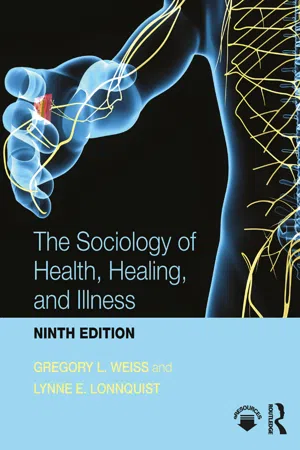
- 520 pages
- English
- ePUB (mobile friendly)
- Available on iOS & Android
The Sociology of Health, Healing, and Illness
About this book
With thorough coverage of inequality in health care access and practice, this leading textbook has been widely acclaimed by teachers as the most accessible of any available.
It introduces and integrates recent research in medical sociology and emphasizes the importance of race, class, gender throughout.
This new edition leads students through the complexities of the evolving Affordable Care Act. It significantly expands coverage of medical technology, end-of-life issues, and alternative and complementary health care—topics students typically debate in the classroom. Many new textboxes and enhancements in pedagogy grace this new edition, which is essential in the fast-changing area of health care.
New to this Edition
*More textboxes relating the social aspects of medicine to students' lives
*Expanded coverage leading students through the complex impacts of the ACA and health care reform
*Expanded coverage of medical technology, end-of-life issues, and alternative and complementary health care
*'Health and the Internet' sections updated and renovated toward student assignments
*New, end of chapter lists of terms
*Updated test bank
Frequently asked questions
- Essential is ideal for learners and professionals who enjoy exploring a wide range of subjects. Access the Essential Library with 800,000+ trusted titles and best-sellers across business, personal growth, and the humanities. Includes unlimited reading time and Standard Read Aloud voice.
- Complete: Perfect for advanced learners and researchers needing full, unrestricted access. Unlock 1.4M+ books across hundreds of subjects, including academic and specialized titles. The Complete Plan also includes advanced features like Premium Read Aloud and Research Assistant.
Please note we cannot support devices running on iOS 13 and Android 7 or earlier. Learn more about using the app.
Information
CHAPTER 1
A Brief Introduction to the Sociology of Health, Healing, and Illness
Learning Objectives
DEFINITION OF MEDICAL SOCIOLOGY
Medical sociology is the subfield which applies the perspectives, conceptualizations, theories, and methodologies of sociology to phenomena having to do with human health and disease. As a specialization, medical sociology encompasses a body of knowledge which places health and disease in a social, cultural, and behavioral context. Included within its subject matter are descriptions and explanations or theories relating to the distribution of diseases among various population groups; the behaviors or actions taken by individuals to maintain, enhance, or restore health or cope with illness, disease, or disability; people’s attitudes and beliefs about health, disease, disability and medical care providers and organizations; medical occupations or professions and the organization, financing, and delivery of medical care services; medicine as a social institution and its relationship to other social institutions; cultural values and societal responses with respect to health, illness, and disability; and the role of social factors in the etiology of disease, especially functional and emotion-related.
HISTORICAL DEVELOPMENT OF MEDICAL SOCIOLOGY
Setting the Foundation: The Importance of Social Factors on Health and Illness
The Turn of the Century: Development of Social Medicine
The Early to Mid-Twentieth Century: More Studies on Health and Medicine
The 1950s and 1960s: The Formal Subdiscipline Emerges
Table of contents
- Cover
- Half Title
- Title Page
- Copyright Page
- Dedication
- Table of Contents
- Preface
- Chapter One A Brief Introduction to the Sociology of Health, Healing, and Illness
- Chapter Two The Development of Scientific Medicine
- Chapter Three Social Epidemiology
- Chapter Four Society, Disease, and Illness
- Chapter Five Social Stress
- Chapter Six Health Behavior
- Chapter Seven Experiencing Illness and Disability
- Chapter Eight Physicians and the Profession of Medicine
- Chapter Nine Medical Education and the Socialization of Physicians
- Chapter Ten Nurses, Advanced Practice Providers, and Allied Health Workers
- Chapter Eleven Complementary and Alternative Medicine
- Chapter Twelve The Physician–Patient Relationship: Background and Models
- Chapter Thirteen Professional and Ethical Obligations of Physicians in the Physician–Patient Relationship
- Chapter Fourteen The Health Care System of the United States
- Chapter Fifteen Health Care Delivery
- Chapter Sixteen The Social Implications of Advanced Health Care Technology
- Chapter Seventeen Comparative Health Care Systems
- Name Index
- Subject Index